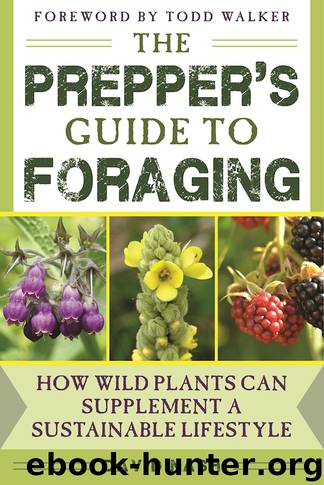The Prepper's Guide to Foraging by David Nash

Author:David Nash
Language: eng
Format: epub
Publisher: The New Press
Published: 2016-04-04T16:00:00+00:00
Dandelion seeds
Scientific Name: Taraxacum officinale
Type of Plant: Perennial
Description: Dandelion is one of my favorite plants; it is everywhere and is pretty useful. In my book 52 Unique Techniques for Stocking Food for Preppers, I used it to make a dandelion wine and described how I first used it as a coffee substitute.
Like other members of the Asteraceae family, dandelions have very small flowers situated together into a composite flower head. Dandelions are tap-rooted herbs and are native to temperate areas of the Northern Hemisphere.
The flower heads are yellow to orange colored, are open in the daytime, and are closed at night.
Natural Range: Dandelions are found on all continents in yards and open areas everywhere.
Food Usage: Roots and leaves have been gathered for food since prehistory, but they are bitter. They are often blanched to remove bitterness or sautéed in the same way as spinach.
Dandelion leaves contain several vitamins and minerals, most notably vitamins A, C, and K, and are also good sources of calcium, potassium, iron, and manganese.
Sautéed Dandelion
Ingredients:
• 3 pounds dandelion greens, tough stems discarded and leaves cut crosswise into 2-inch pieces
• ½ cup extra-virgin olive oil
• 5 large garlic cloves, minced
• ¼ to ½ teaspoon dried hot red pepper flakes
• ½ teaspoon fine sea salt
Preparation:
• Cook greens in a 10- to 12-quart pot of boiling, salted water, uncovered, until ribs are tender (about 10 minutes)
• Drain in a colander, then rinse under cold water and drain, gently pressing out excess water.
• Heat oil in a 12-inch heavy skillet over medium heat.
• Cook garlic and red pepper flakes, stirring, until pale golden, about 45 seconds.
• Increase heat to medium-high.
• Add greens and sea salt.
• Sauté until coated with oil and heated through (about 4 minutes).
Alternative Usage: In almost every culture, the root of the dandelion has been used for the treatment of liver and gallbladder problems, especially the incomplete digestion of fats.
Dandelion Tincture
Use six to twelve drops in juice or water, under the tongue or as desired. It may be taken three times daily to help stimulate urination and bile production and help break down fats.
Materials:
• Fresh clean dandelion roots and leaves
• 90-proof vodka or pure grain alcohol
Procedure:
• Place dandelion pieces in a clean container.
• Add the alcohol at a 2:1 ratio (i.e. 2 cups of vodka to 1 cup of fresh plant material).
• Put the lid on the jar.
• Store the jar in a cool/dry place.
• Shake daily for at least three weeks and up to six months.
• Strain through cheesecloth and compost the herbs.
• Store the tincture in colored dropper bottles or clean glass jars.
Note: Man has eaten dandelion roots going back at least 25,000 years. Check with your doctor before using this or any herb, especially if you have a liver or gallbladder disorder.
Unlike most root plants that are harvested in the fall, dandelion roots should be harvested in the spring.
Download
This site does not store any files on its server. We only index and link to content provided by other sites. Please contact the content providers to delete copyright contents if any and email us, we'll remove relevant links or contents immediately.
The Sprouting Book by Ann Wigmore(3543)
Better Homes and Gardens New Cookbook by Better Homes & Gardens(3526)
Trullo by Tim Siadatan(3380)
Super Food Family Classics by Jamie Oliver(3368)
Hedgerow by John Wright(3277)
Panini by Carlo Middione(3252)
Bread Revolution by Peter Reinhart(3087)
Sauces by James Peterson(3051)
Jam by Jam (epub)(3026)
Ottolenghi - The Cookbook by Yotam Ottolenghi(2871)
Oh She Glows Every Day by Angela Liddon(2730)
My Pantry by Alice Waters(2547)
Hot Sauce Nation by Denver Nicks(2451)
The Culinary Herbal by Susan Belsinger(2432)
Veg by Jamie Oliver(2411)
Wanderlust by Jeff Krasno(2225)
Meathooked by Marta Zaraska(2220)
The Art of Making Gelato by Morgan Morano(2216)
Basic Illustrated Edible and Medicinal Mushrooms by Jim Meuninck(2187)
